Temporal Dynamics and Long-Term Trends in Aerosol Optical Properties over Two Sites of Indo Gangetic Plains (IGP): Insights from AERONET Observations
Abstract
1. Introduction
2. Methodology and Data
2.1. Study Area
2.2. AERONET
2.3. HYSPLIT (Hybrid Single-Particle Lagrangian Integrated Trajectory Model)
2.4. Trend Analysis
3. Results
3.1. Aerosol Optical Depth (AOD) and Angstrom Exponent (α)
3.2. Frequency Distribution
3.3. Single Scattering Albedo (SSA)
3.4. Precipitable Water Vapor (PW)
3.5. Long-Term Seasonal Trend Analysis
3.6. Sub-Period Analysis and Comparison of Aerosol Characteristics
3.7. Back Air Mass Trajectory
4. Discussion
5. Conclusions
Supplementary Materials
Author Contributions
Funding
Institutional Review Board Statement
Informed Consent Statement
Data Availability Statement
Acknowledgments
Conflicts of Interest
References
- Myhre, G.; Samset, B.H.; Schulz, M.; Balkanski, Y.; Bauer, S.; Berntsen, T.K.; Bian, H.; Bellouin, N.; Chin, M.; Diehl, T. Radiative forcing of the direct aerosol effect from AeroCom Phase II simulations. Atmos. Chem. Phys. 2013, 13, 1853–1877. [Google Scholar] [CrossRef]
- Ramanathan, V.; Crutzen, P.J.; Kiehl, J.T.; Rosenfeld, D. Aerosols, climate, and the hydrological cycle. Science 2001, 294, 2119–2124. [Google Scholar] [CrossRef] [PubMed]
- Lohmann, U.; Stier, P.; Hoose, C.; Ferrachat, S.; Kloster, S.; Roeckner, E.; Zhang, J. Cloud microphysics and aerosol indirect effects in the global climate model ECHAM5-HAM. Atmos. Chem. Phys. 2007, 7, 3425–3446. [Google Scholar] [CrossRef]
- Manisalidis, I.; Stavropoulou, E.; Stavropoulos, A.; Bezirtzoglou, E. Environmental and health impacts of air pollution: A review. Front. Public Health 2020, 8, 14. [Google Scholar] [CrossRef]
- Filonchyk, M.; Yan, H. The characteristics of air pollutants during different seasons in the urban area of Lanzhou, Northwest China. Environ. Earth Sci. 2018, 77, 1–17. [Google Scholar] [CrossRef]
- Hsu, S.; Liu, S.C.; Huang, Y.; Chou, C.C.K.; Lung, S.C.C.; Liu, T.; Tu, J.; Tsai, F. Long-range southeastward transport of Asian biosmoke pollution: Signature detected by aerosol potassium in northern Taiwan. J. Geophys. Res. Atmos. 2009, 114, D14. [Google Scholar] [CrossRef]
- Zhang, Z.; Wenig, M.; Zhou, W.; Diehl, T.; Chan, K.-L.; Wang, L. The contribution of different aerosol sources to the Aerosol Optical Depth in Hong Kong. Atmos. Environ. 2014, 83, 145–154. [Google Scholar] [CrossRef]
- Jethva, H.; Satheesh, S.K.; Srinivasan, J. Seasonal variability of aerosols over the Indo-Gangetic basin. J. Geophys. Res. Atmos. 2005, 110, D21. [Google Scholar] [CrossRef]
- Dey, S.; di Girolamo, L. A climatology of aerosol optical and microphysical properties over the Indian subcontinent from 9 years (2000–2008) of Multiangle Imaging Spectroradiometer (MISR) data. J. Geophys. Res. Atmos. 2010, 115, D15204. [Google Scholar] [CrossRef]
- Lee, H.J.; Son, Y.S. Spatial variability of AERONET aerosol optical properties and satellite data in South Korea during NASA DRAGON-Asia campaign. Environ. Sci. Technol. 2016, 50, 3954–3964. [Google Scholar] [CrossRef]
- Rupakheti, D.; Kang, S.; Bilal, M.; Gong, J.; Xia, X.; Cong, Z. Aerosol optical depth climatology over Central Asian countries based on Aqua-MODIS Collection 6.1 data: Aerosol variations and sources. Atmos. Environ. 2019, 207, 205–214. [Google Scholar] [CrossRef]
- Eom, S.; Kim, J.; Lee, S.; Holben, B.N.; Eck, T.F.; Park, S.B.; Park, S.S. Long-term variation of aerosol optical properties associated with aerosol types over East Asia using AERONET and satellite (VIIRS, OMI) data (2012–2019). Atmos. Res. 2022, 280, 106457. [Google Scholar] [CrossRef]
- Ansari, K.; Ramachandran, S. Aerosol characteristics over Indo-Gangetic Plain from ground-based AERONET and MERRA-2/CAMS model simulations. Atmos. Environ. 2023, 293, 119434. [Google Scholar] [CrossRef]
- Li, J.; Carlson, B.E.; Yung, Y.L.; Lv, D.; Hansen, J.; Penner, J.E.; Liao, H.; Ramaswamy, V.; Kahn, R.A.; Zhang, P. Scattering and absorbing aerosols in the climate system. Nat. Rev. Earth Environ. 2022, 3, 363–379. [Google Scholar] [CrossRef]
- Reid, J.S.; Hyer, E.J.; Johnson, R.S.; Holben, B.N.; Yokelson, R.J.; Zhang, J.; Campbell, J.R.; Christopher, S.A.; Di Girolamo, L.; Giglio, L.; et al. Observing and understanding the Southeast Asian aerosol system by remote sensing: An initial review and analysis for the Seven Southeast Asian Studies (7SEAS) program. Atmos. Res. 2013, 122, 403–468. [Google Scholar] [CrossRef]
- Kokhanovsky, A.A.; Davis, A.B.; Cairns, B.; Dubovik, O.; Hasekamp, O.P.; Sano, I.; Mukai, S.; Rozanov, V.V.; Litvinov, P.; Lapyonok, T.; et al. Space-based remote sensing of atmospheric aerosols: The multi-angle spectro-polarimetric frontier. Earth Sci. Rev. 2015, 145, 85–116. [Google Scholar] [CrossRef]
- Verma, S.; Prakash, D.; Soni, M.; Ram, K. Atmospheric aerosols monitoring: Ground and satellite-based instruments. In Advances in Environmental Monitoring and Assessment; IntechOpen: London, UK, 2019; pp. 67–80. [Google Scholar]
- Gupta, G.; Ratnam, M.V.; Madhavan, B.L.; Jayaraman, A. Global trends in the aerosol optical, physical, and morphological properties obtained using multi-sensor measurements. Atmos. Environ. 2023, 295, 119569. [Google Scholar] [CrossRef]
- Remer, L.A.; Knobelspiesse, K.; Zhai, P.W.; Xu, F.; Kalashnikova, O.V.; Chowdhary, J.; Hasekamp, O.; Dubovik, O.; Wu, L.; Ahmad, Z.; et al. Retrieving aerosol characteristics from the PACE mission, Part 2: Multi-angle and polarimetry. Front. Environ. Sci. 2019, 7, 94. [Google Scholar] [CrossRef]
- Holben, B.N.; Eck, T.F.; Slutsker, I.; Tanré, D.; Buis, J.P.; Setzer, A.; Vermote, E.; Reagan, J.A.; Kaufman, Y.J.; Nakajima, T. AERONET—A federated instrument network and data archive for aerosol characterization. Remote Sens. Environ. 1998, 66, 1–16. [Google Scholar] [CrossRef]
- Nakajima, T.Y.; Ohta, S. Significance of direct and indirect radiative forcings of aerosols in the East China Sea region. J. Geophys. Res. Atmos. 2003, 108, D23. [Google Scholar] [CrossRef]
- Dong, X.; Chen, B.; Yamazaki, A.; Shi, G.; Tang, N. Variations in aerosol optical characteristics from SKYNET measurements in Beijing. Atmos. Environ. 2023, 302, 119747. [Google Scholar] [CrossRef]
- Li, Z.Q.; Xu, H.; Li, K.T.; Li, D.H.; Xie, Y.S.; Li, L.; Zhang, Y.; Gu, X.F.; Zhao, W.; Tian, Q.J. Comprehensive study of optical, physical, chemical, and radiative properties of total columnar atmospheric aerosols over China: An overview of Sun–Sky Radiometer Observation Network (SONET) measurements. Bull. Am. Meteorol. Soc. 2018, 99, 739–755. [Google Scholar] [CrossRef]
- Dubovik, O.; King, M.D. A flexible inversion algorithm for retrieval of aerosol optical properties from Sun and sky radiance measurements. J. Geophys. Res. Atmos. 2000, 105, 20673–20696. [Google Scholar] [CrossRef]
- Giles, D.M.; Sinyuk, A.; Sorokin, M.G.; Schafer, J.S.; Smirnov, A.; Slutsker, I.; Eck, T.F.; Holben, B.N.; Lewis, J.R.; Campbell, J.R. Advancements in the Aerosol Robotic Network (AERONET) Version 3 database-automated near-real-time quality control algorithm with improved cloud screening for Sun photometer aerosol optical depth (AOD) measurements. Atmos. Meas. Tech. 2019, 12, 169–209. [Google Scholar] [CrossRef]
- Boiyo, R.; Kumar, K.R.; Zhao, T.; Guo, J. A 10-year record of aerosol optical properties and radiative forcing over three environmentally distinct AERONET sites in Kenya, East Africa. J. Geophys. Res. Atmos. 2019, 124, 1596–1617. [Google Scholar] [CrossRef]
- Hu, Y.; Kang, S.; Yang, J.; Ji, Z.; Rupakheti, D.; Yin, X.; Du, H. Impact of atmospheric circulation patterns on properties and regional transport pathways of aerosols over Central-West Asia: Emphasizing the Tibetan Plateau. Atmos. Res. 2022, 266, 105975. [Google Scholar] [CrossRef]
- El-Nadry, M.; Li, W.; El-Askary, H.; Awad, M.A.; Mostafa, A.R. Urban health related air quality indicators over the Middle East and North Africa countries using multiple satellites and AERONET data. Remote Sens. 2019, 11, 2096. [Google Scholar] [CrossRef]
- Liu, C.; Yang, L.; Che, H.; Xia, X.; Zhao, H.; Wang, H.; Gui, K.; Zheng, Y.; Sun, T.; Li, X. Aerosol optical properties over an urban site in Central China determined using ground-based sun photometer measurements. Aerosol Air Qual. Res. 2019, 19, 620–638. [Google Scholar] [CrossRef]
- Glantz, P.; Freud, E.; Johansson, C.; Noone, K.J.; Tesche, M. Trends in MODIS and AERONET derived aerosol optical thickness over Northern Europe. Tellus B Chem. Phys. Meteorol. 2019, 71, 1554414. [Google Scholar] [CrossRef]
- Eibedingil, I.G.; Gill, T.E.; van Pelt, R.S.; Tong, D.Q. Comparison of aerosol optical depth from MODIS product collection 6.1 and AERONET in the Western United States. Remote Sens. 2021, 13, 2316. [Google Scholar] [CrossRef]
- Gurjar, B.R.; Ravindra, K.; Nagpure, A.S. Air pollution trends over Indian megacities and their local-to-global implications. Atmos. Environ. 2016, 142, 475–495. [Google Scholar] [CrossRef]
- Kaur, R.R.; Luthra, A. Population growth, urbanization and electricity-Challenges and initiatives in the state of Punjab, India. Energy Strategy Rev. 2018, 21, 50–61. [Google Scholar] [CrossRef]
- Kumar, A. Spatio-temporal variations in satellite-based aerosol optical depths & aerosol index over Indian subcontinent: Impact of urbanization and climate change. Urban Clim. 2020, 32, 100598. [Google Scholar]
- Kumar, M.; Parmar, K.S.; Kumar, D.B.; Mhawish, A.; Broday, D.M.; Mall, R.K.; Banerjee, T. Long-term aerosol climatology over Indo-Gangetic Plain: Trend, prediction and potential source fields. Atmos. Environ. 2018, 180, 37–50. [Google Scholar] [CrossRef]
- Shukla, K.K.; Attada, R.; Sarangi, C.; Kunchala, R.K.; Devulapalli, V.P. Exploring the factors responsible for aerosol asymmetric trends over Indo-Gangetic Plain using remote sensing observations. J. Atmos. Sol. Terr. Phys. 2024, 258, 106220. [Google Scholar] [CrossRef]
- Krishna Moorthy, K.; Suresh Babu, S.; Manoj, M.R.; Satheesh, S.K. Buildup of aerosols over the Indian Region. Geophys. Res. Lett. 2013, 40, 1011–1014. [Google Scholar] [CrossRef]
- Kumar, A.; Pratap, V.; Kumar, S.; Singh, A.K. Atmospheric aerosols properties over Indo-Gangetic Plain: A trend analysis using ground–truth AERONET data for the year 2009–2017. Adv. Space Res. 2022, 69, 2659–2670. [Google Scholar] [CrossRef]
- Banerjee, T.; Murari, V.; Kumar, M.; Raju, M.P. Source apportionment of airborne particulates through receptor modeling: Indian scenario. Atmos. Res. 2015, 164, 167–187. [Google Scholar] [CrossRef]
- Singh, S.; Lodhi, N.K.; Mishra, A.K.; Jose, S.; Kumar, S.N.; Kotnala, R.K. Assessment of satellite-retrieved surface UVA and UVB radiation by comparison with ground-measurements and trends over Mega-city Delhi. Atmos. Environ. 2018, 188, 60–70. [Google Scholar] [CrossRef]
- Srivastava, A.K.; Dey, S.; Tripathi, S.N. Aerosol characteristics over the Indo-Gangetic basin: Implications to regional climate. Atmos. Aerosol Reg. Charact. Chem. Phys. 2012, 10, 47782. [Google Scholar]
- Srivastava, A.K.; Thomas, A.; Hooda, R.K.; Kanawade, V.P.; Hyvärinen, A.-P.; Bisht, D.S.; Tiwari, S. How secondary inorganic aerosols from Delhi influence aerosol optical and radiative properties at a downwind sub-urban site over Indo-Gangetic Basin? Atmos. Environ. 2021, 248, 118246. [Google Scholar] [CrossRef]
- Sharma, A.R.; Kharol, S.K.; Badarinath, K.V.S.; Singh, D. Impact of agriculture crop residue burning on atmospheric aerosol loading—A study over Punjab State, India. Ann. Geophys. 2010, 28, 367–379. [Google Scholar] [CrossRef]
- Kanawade, V.P.; Tripathi, S.N.; Chakraborty, A.; Yu, H. Chemical characterization of sub-micron aerosols during new particle formation in an urban atmosphere. Aerosol Air Qual. Res. 2020, 20, 1294–1305. [Google Scholar] [CrossRef]
- Ghude, S.D.; Chate, D.M.; Jena, C.; Beig, G.; Kumar, R.; Barth, M.C.; Pfister, G.G.; Fadnavis, S.; Pithani, P. Premature mortality in India due to PM2.5 and ozone exposure. Geophys. Res. Lett. 2016, 43, 4650–4658. [Google Scholar] [CrossRef]
- Prasad, A.K.; Singh, R.P. Changes in aerosol parameters during major dust storm events (2001–2005) over the Indo-Gangetic Plains using AERONET and MODIS data. J. Geophys. Res. Atmos. 2007, 112, D9. [Google Scholar] [CrossRef]
- Ramachandran, S.; Rupakheti, M. Trends in the types and absorption characteristics of ambient aerosols over the Indo-Gangetic Plain and North China Plain in last two decades. Sci. Total Environ. 2022, 831, 154867. [Google Scholar] [CrossRef]
- Nair, M.; Dey, S.; Bherwani, H.; Ghosh, A.K. Long-term changes in aerosol loading over the ‘BIHAR’ State of India using nineteen years (2001–2019) of high-resolution satellite data (1 × 1 km2). Atmos. Pollut. Res. 2022, 13, 101259. [Google Scholar] [CrossRef]
- Kaskaoutis, D.G.; Singh, R.P.; Gautam, R.; Sharma, M.; Kosmopoulos, P.G.; Tripathi, S.N. Variability and trends of aerosol properties over Kanpur, northern India using AERONET data (2001–2010). Environ. Res. Lett. 2012, 7, 024003. [Google Scholar] [CrossRef]
- Bibi, H.; Alam, K.; Blaschke, T.; Bibi, S.; Iqbal, M.J. Long-term (2007–2013) analysis of aerosol optical properties over four locations in the Indo-Gangetic plains. Appl. Opt. 2016, 55, 6199–6211. [Google Scholar] [CrossRef]
- Choudhry, P.; Misra, A.; Tripathi, S.N. Study of MODIS derived AOD at three different locations in the Indo Gangetic Plain: Kanpur, Gandhi College and Nainital. Ann. Geophys. 2012, 30, 1479–1493. [Google Scholar] [CrossRef]
- Varpe, S.R.; Kolhe, A.R.; Kutal, G.C.; Pawar, G.V.; Payra, S.; Budhavant, K.B.; Aher, G.R.; Devara, P.C.S. Heterogeneity in aerosol characteristics at the semi-arid and island AERONET observing sites in India and Maldives. Int. J. Remote Sens. 2018, 39, 6137–6169. [Google Scholar] [CrossRef]
- Dubovik, O.; Smirnov, A.; Holben, B.N.; King, M.D.; Kaufman, Y.J.; Eck, T.F.; Slutsker, I. Accuracy assessments of aerosol properties retrieved from Aerosol Robotic Network (AERONET) sun and sky radiance measurements. J. Geophys. Res. 2000, 105, 9791–9806. [Google Scholar] [CrossRef]
- Eck, T.F.; Holben, B.N.; Reid, J.S.; Dubovik, O.; Smirnov, A.; O’Neill, N.T.; Slutsker, I.; Kinne, S. Wavelength dependence of the optical depth of biomass burning, urban, and desert dust aerosols. J. Geophys. Res. Atmos. 1999, 104, 31333–31349. [Google Scholar]
- Smirnov, A.; Holben, B.N.; Eck, T.F.; Dubovik, O.; Slutsker, I. Cloud screening and quality control algorithms for the AERONET database. Remote Sens. Environ. 2000, 73, 337–349. [Google Scholar] [CrossRef]
- Draxler, R.R. Measuring and modeling the transport and dispersion of krypton-85 1500 km from a point source. Atmos. Environ. 1982, 16, 2763–2776. [Google Scholar] [CrossRef]
- Kulshrestha, U.; Kumar, B. Air mass trajectories and long-range transport of pollutants: Review of wet deposition scenario in South Asia. Adv. Meteorol. 2014, 2014, 596041. [Google Scholar] [CrossRef]
- Bella, D.; Culpepper, J.; Khaimova, J.; Ahmed, N.; Belkalai, A.; Arroyo, I.; Andrews, J.; Gentle, S.; Emmanuel, S.; Lahmouh, M.; et al. Characterization of pollution transport into Texas using OMI and TES satellite, GIS, in situ data, and HYSPLIT back trajectory analyses: Implications for TCEQ State Implementation Plans. Air Qual. Atmos. Health 2016, 9, 569–588. [Google Scholar] [CrossRef]
- Ma, Y.; Wang, M.; Wang, S.; Wang, Y.; Feng, L.; Wu, K. Air pollutant emission characteristics and HYSPLIT model analysis during the heating period in Shenyang, China. Environ. Monit. Assess. 2021, 193, 1–14. [Google Scholar] [CrossRef]
- Shan, M.; Wang, Y.; Lu, Y.; Liang, C.; Wang, T.; Li, L.; Li, R.Y.M. Uncovering PM2.5 transport trajectories and sources at district within city scale. J. Clean. Prod. 2023, 423, 138608. [Google Scholar] [CrossRef]
- Whitaker, J.S.; Hamill, T.M.; Wei, X.; Song, Y.; Toth, Z. Ensemble data assimilation with the NCEP global forecast system. Mon. Weather Rev. 2008, 136, 463–482. [Google Scholar] [CrossRef]
- Mann, H.B. Nonparametric tests against trend. Econom. J. Econom. Soc. 1945, 13, 245–259. [Google Scholar] [CrossRef]
- Kendall, M.G. Rank Correlation Methods, 4th ed.; Charles Griffin: London, UK, 1975. [Google Scholar]
- Srivastava, A.; Saran, S. Comprehensive study on AOD trends over the Indian subcontinent: A statistical approach. Int. J. Remote Sens. 2017, 38, 5127–5149. [Google Scholar] [CrossRef]
- Sayer, A.M.; Hsu, N.C.; Bettenhausen, C.; Jeong, M.J.; Meister, G. Effect of MODIS Terra radiometric calibration improvements on Collection 6 Deep Blue aerosol products: Validation and Terra/Aqua consistency. J. Geophys. Res. Atmos. 2015, 120, 12–157. [Google Scholar] [CrossRef]
- Filonchyk, M.; Yan, H.; Zhang, Z. Analysis of spatial and temporal variability of aerosol optical depth over China using MODIS combined Dark Target and Deep Blue product. Theor. Appl. Climatol. 2019, 137, 2271–2288. [Google Scholar] [CrossRef]
- Wang, Y.; Yuan, Q.; Li, T.; Shen, H.; Zheng, L.; Zhang, L. Evaluation and comparison of MODIS Collection 6.1 aerosol optical depth against AERONET over regions in China with multifarious underlying surfaces. Atmos. Environ. 2019, 200, 280–301. [Google Scholar] [CrossRef]
- Holben, B.N.; Tanré, D.; Smirnov, A.; Eck, T.F.; Slutsker, I.; Abuhassan, N.; Newcomb, W.W.; Schafer, J.S.; Chatenet, B.; Lavenu, F. An emerging ground-based aerosol climatology: Aerosol optical depth from AERONET. J. Geophys. Res. Atmos. 2001, 106, 12067–12097. [Google Scholar] [CrossRef]
- Kumar, K.R.; Narasimhulu, K.; Reddy, R.R.; Gopal, K.R.; Reddy, L.S.S.; Balakrishnaiah, G.; Moorthy, K.K.; Babu, S.S. Temporal and spectral characteristics of aerosol optical depths in a semi-arid region of southern India. Sci. Total Environ. 2009, 407, 2673–2688. [Google Scholar] [CrossRef]
- American Meteorological Society. Precipitable Water Vapor, Glossary of Meteorology. 2014. Available online: http://glossary.ametsoc.org/wiki/term (accessed on 8 November 2024).
- Khan, A.A.; Garsa, K.; Jindal, P.; Devara, P.C.S.; Tiwari, S.; Sharma, P.B. Demographic evaluation and parametric assessment of air pollutants over Delhi NCR. Atmosphere 2023, 14, 1390. [Google Scholar] [CrossRef]
- Saha, A.; Krishna Moorthy, K. Impact of precipitation on aerosol spectral optical depth and retrieved size distributions: A case study. J. Appl. Meteorol. 2004, 43, 902–914. [Google Scholar] [CrossRef]
- Garsa, K.; Khan, A.A.; Jindal, P.; Middey, A.; Luqman, N.; Mohanty, H.; Tiwari, S. Assessment of meteorological parameters on air pollution variability over Delhi. Environ. Monit. Assess. 2023, 195, 1315. [Google Scholar] [CrossRef]
- Kedia, S.; Ramachandran, S.; Holben, B.N.; Tripathi, S.N. Quantification of aerosol type, and sources of aerosols over the Indo-Gangetic Plain. Atmos. Environ. 2014, 98, 607–619. [Google Scholar] [CrossRef]
- Sarkar, S.; Kuttippurath, J.; Patel, V.K. Long-term changes in precipitable water vapour over India derived from satellite and reanalysis data for the past four decades (1980–2020). Environ. Sci. Atmos. 2023, 3, 749–759. [Google Scholar] [CrossRef]
- Singh, A.; Rastogi, N.; Sharma, D.; Singh, D. Inter and intra-annual variability in aerosol characteristics over northwestern Indo-Gangetic Plain. Aerosol. Air Qual. Res. 2015, 15, 376–386. [Google Scholar] [CrossRef]
- Ramachandran, S.; Srivastava, R.; Kedia, S.; Rajesh, T.A. Contribution of natural and anthropogenic aerosols to optical properties and radiative effects over an urban location. Environ. Res. Lett. 2012, 7, 034028. [Google Scholar] [CrossRef]
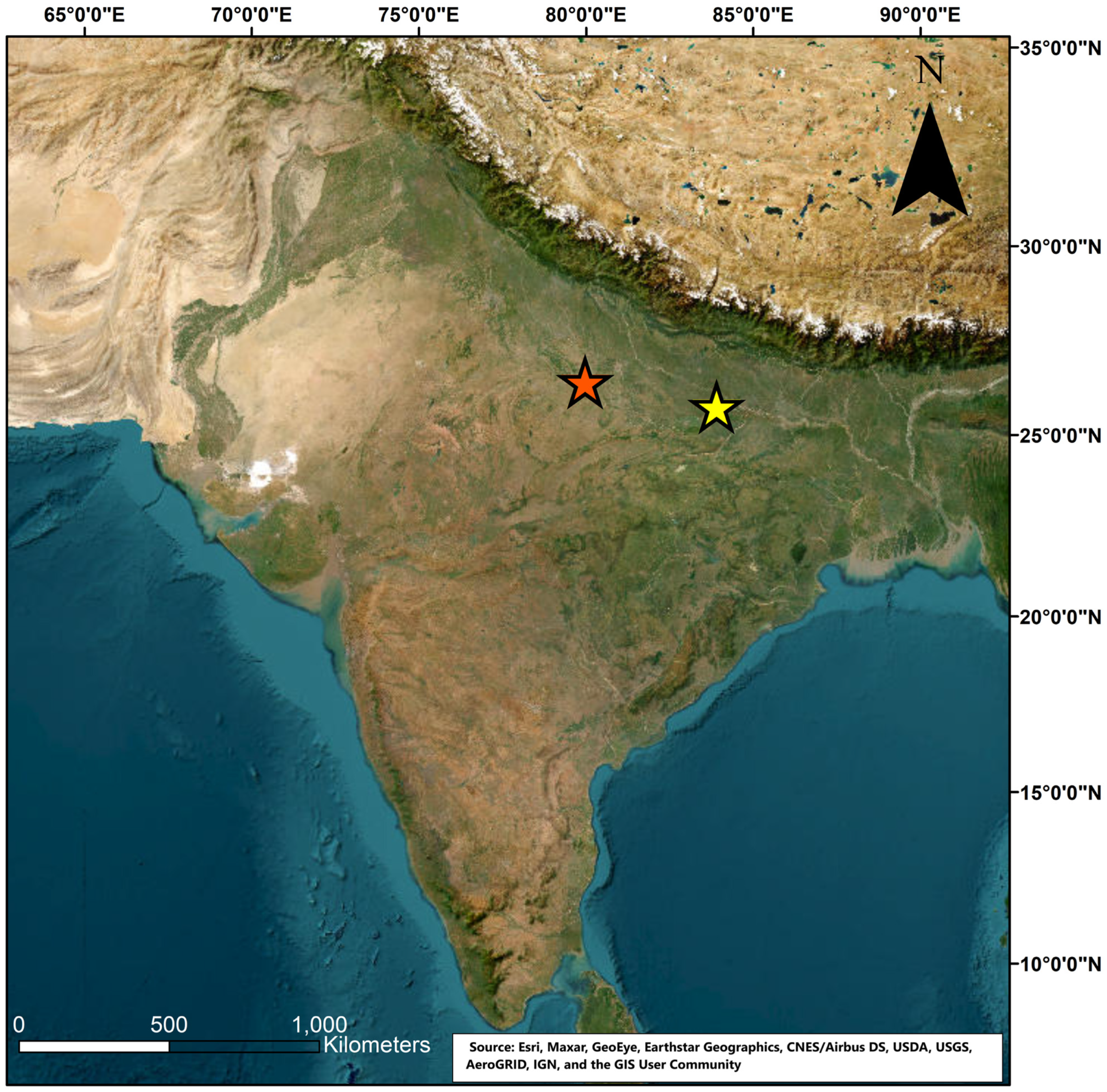


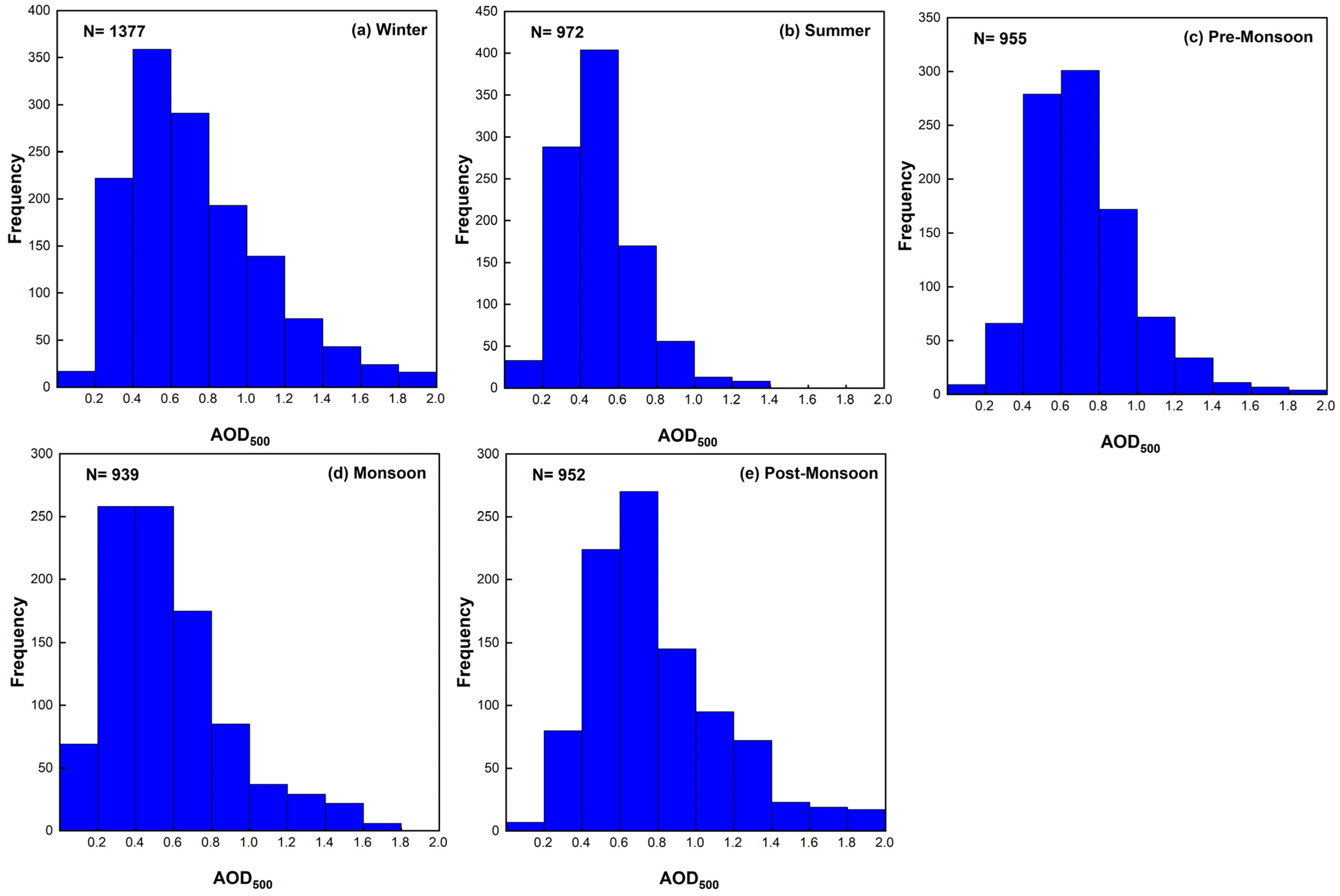
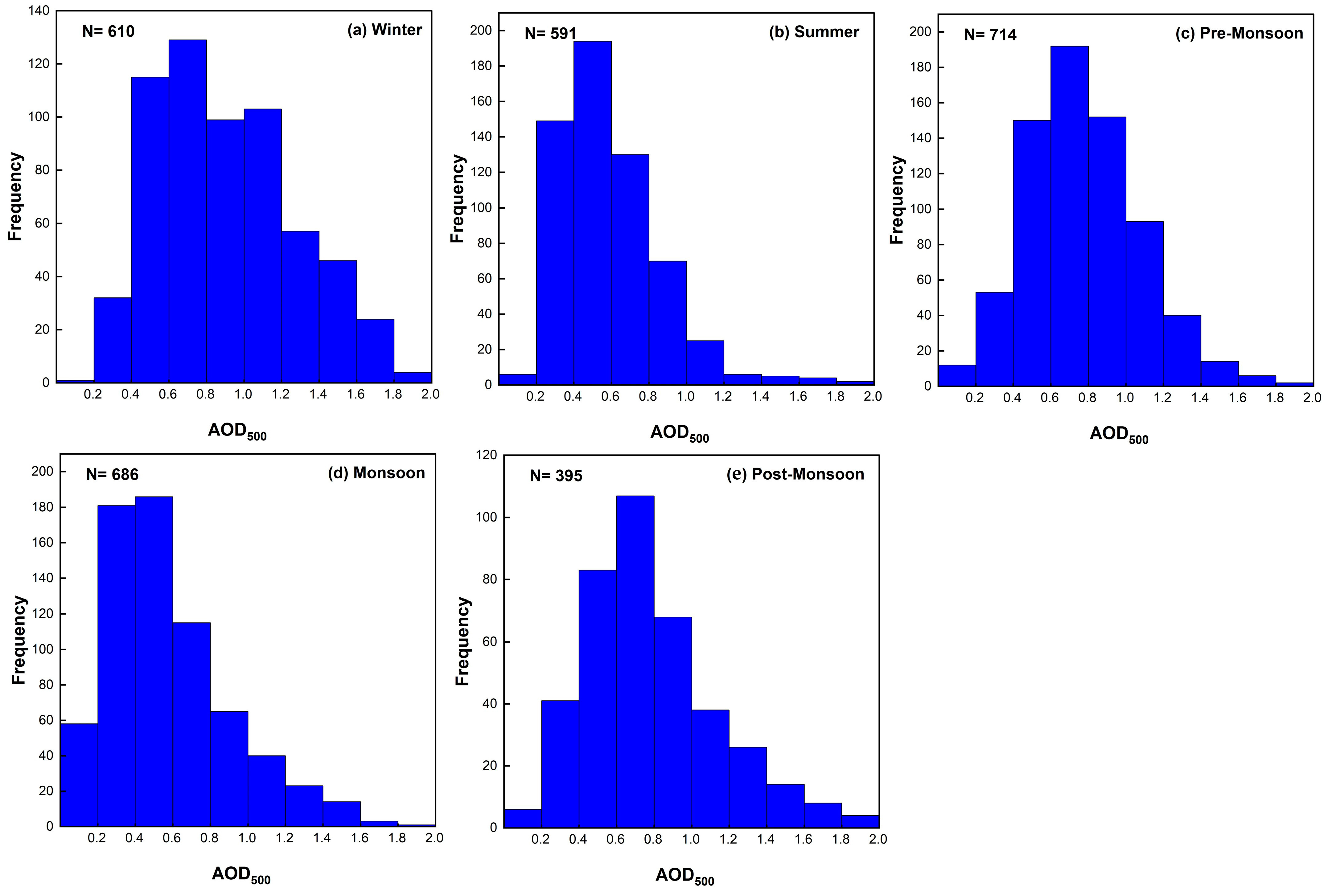
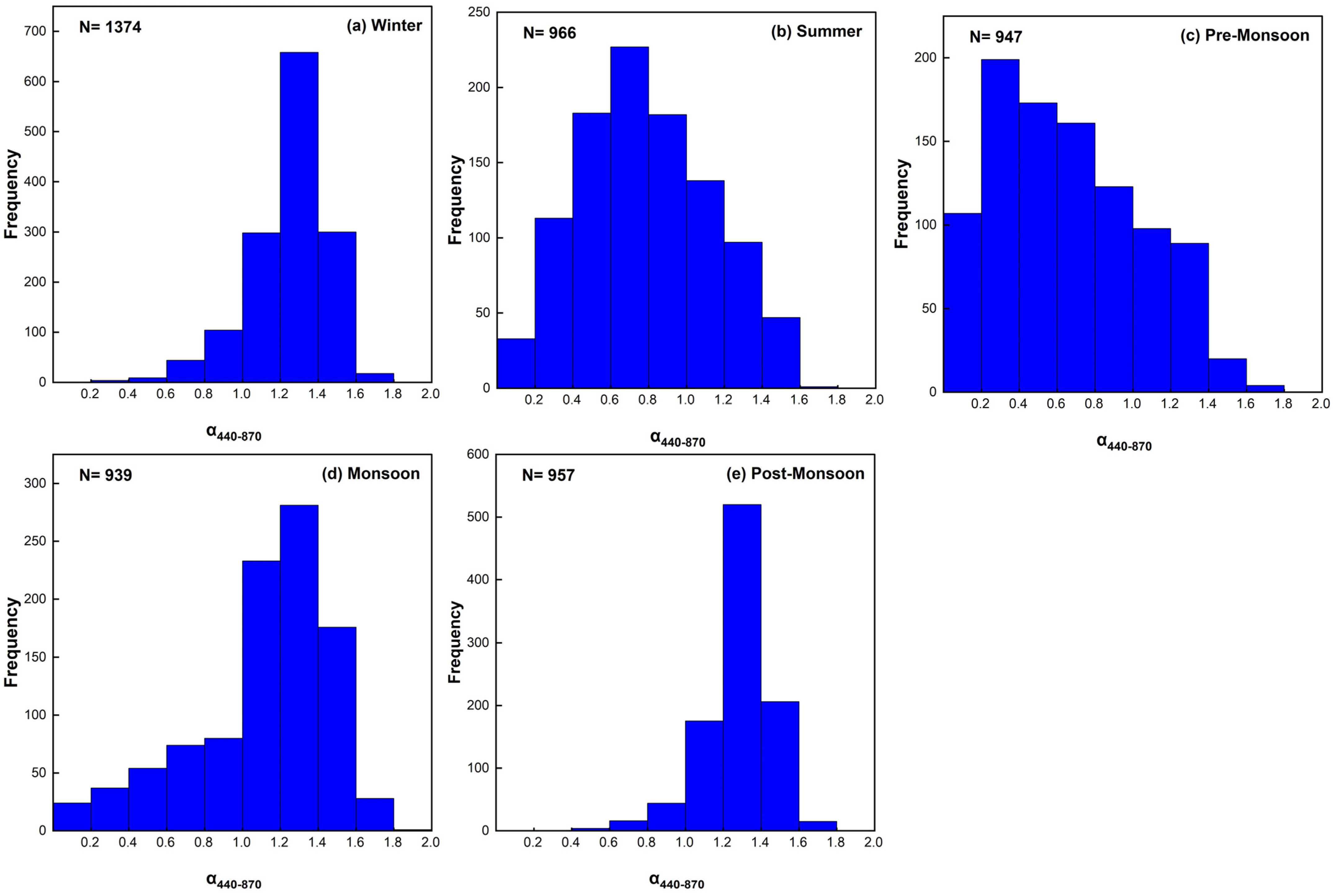
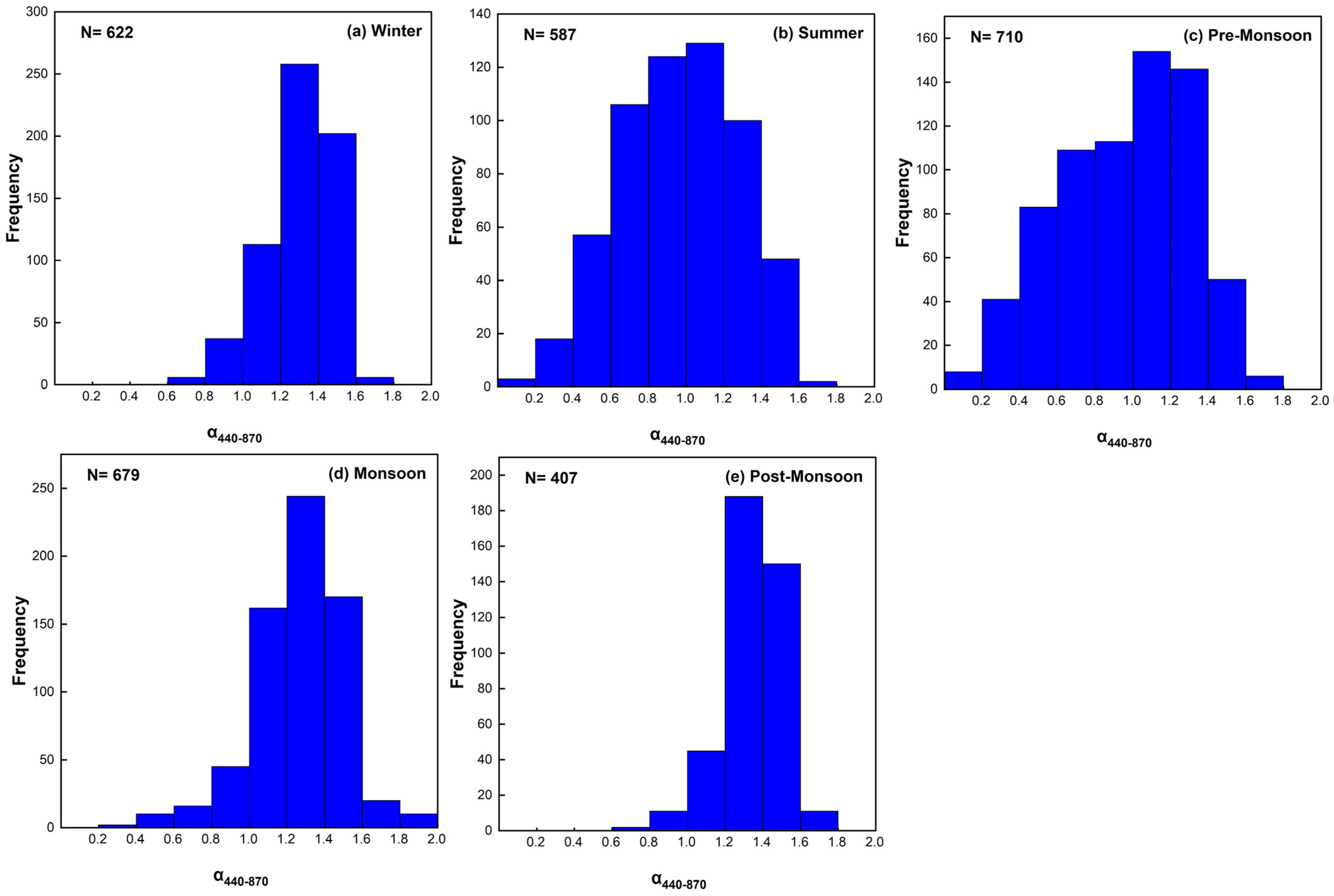
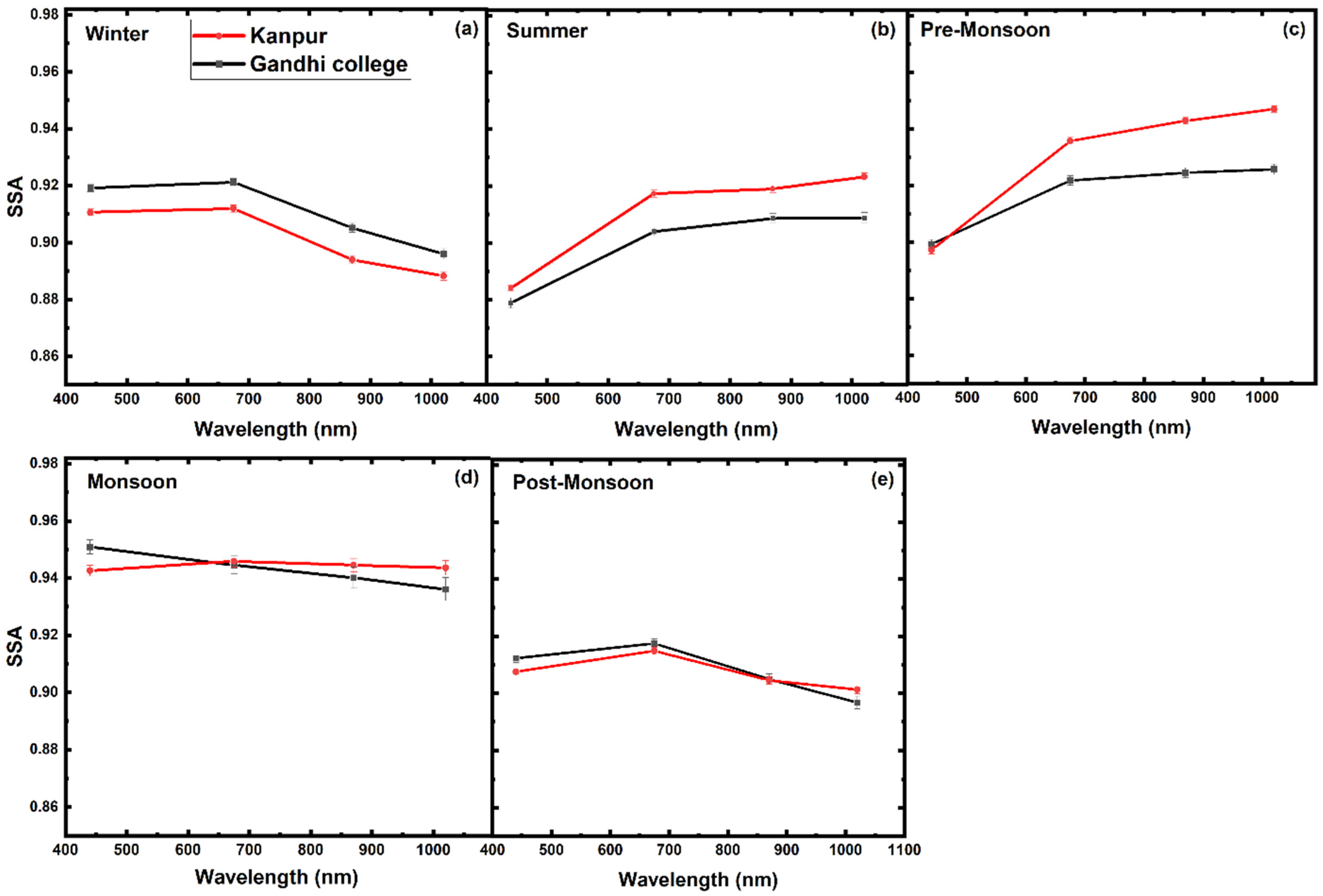
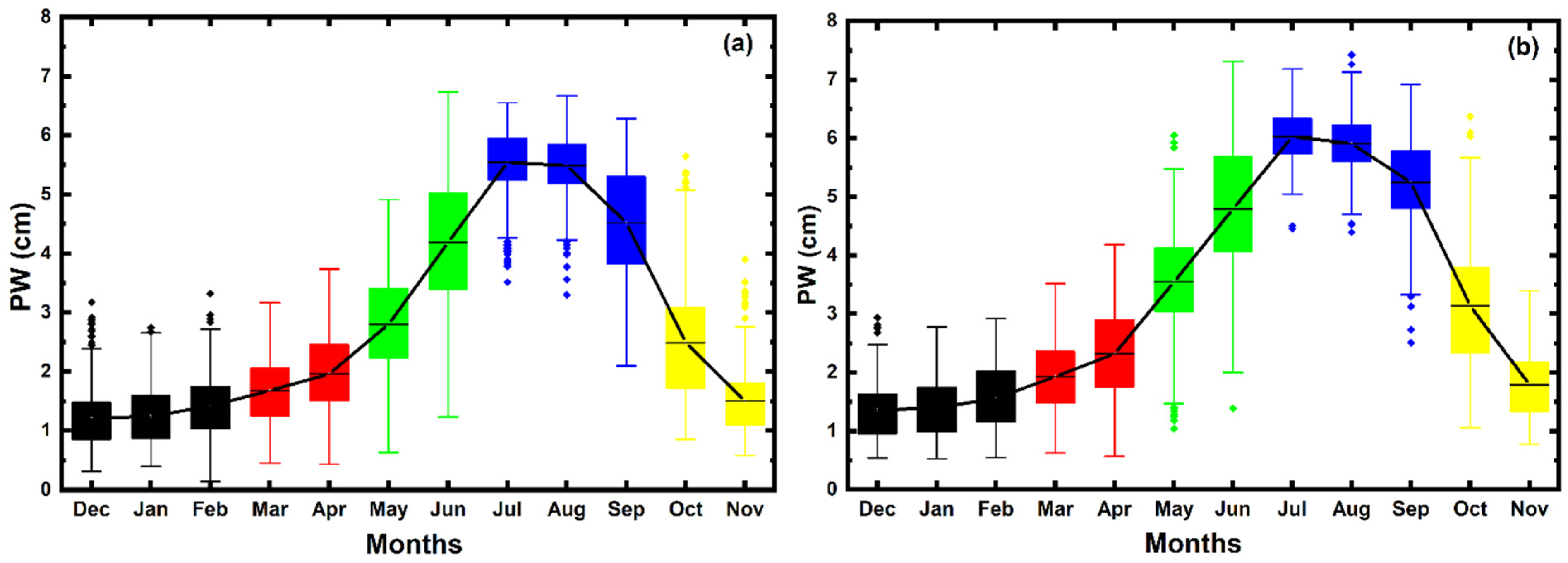
| Kanpur (2001–2022) | Gandhi College (2006–2023) | |||||||
|---|---|---|---|---|---|---|---|---|
| Mean ± S.E | Trend/Year | (%) | p | Mean ± S.E | Trend/Year | (%) | p | |
| AOD (500 nm) | 0.67 ± 0.01 | 0.0056776 | 18.62 | 0.001 | 0.72 ± 0.23 | 0.0123218 | 28.93 | 0.002 |
| AE (440–870 nm) | 1.03 ± 0.02 | 0.0093563 | 20.06 | 0.0002 | 1.12 ± 0.02 | 0.0097700 | 14.41 | 0.025 |
| PW | 2.60 ± 0.06 | 0.0156395 | 13.24 | 0.104 | 3.30 ± 0.15 | −0.0484076 | −24.95 | 0.093 |
| Kanpur (2001–2022) | Gandhi College (2006–2023) | |||||||
| Mean ± S.E (N) | Trend/Day | (%) | p | Mean ± S.E (N) | Trend/Day | (%) | p | |
| AOD (500 nm) | 0.67 ± 0.005 (5208) | 0.000023 | 17.83 | 0.0000 | 0.74 ± 0.01 (3051) | 0.0000644 | 26.73 | 0.0000 |
| AE (440–870 nm) | 1.03 ± 0.01 (5208) | 0.0000294 | 14.86 | 0.0000 | 1.15 ± 0.01 (3051) | 0.0000611 | 16.18 | 0.0000 |
| PW | 2.61 ± 0.02 (5208) | 0.0000528 | 10.51 | 0.0000 | 3.31 ± 0.03 (3051) | −0.000163 | −15.01 | 0.0000 |
| SSA (440 nm) | 0.91 ± 0.001 (3916) | 0.0000122 | 5.28 | 0.0000 | 0.91 ± 0.001 (2193) | 0.0000087 | 2.10 | 0.0000 |
| SSA (675 nm) | 0.92 ± 0.001 (3916) | 0.0000115 | 4.88 | 0.0000 | 0.92 ± 0.001 (2193) | 0.0000037 | 0.88 | 0.001 |
| SSA (870 nm) | 0.92 ± 0.001 (3916) | 0.0000101 | 4.32 | 0.0000 | 0.92 ± 0.001 (2193) | −0.0000039 | −0.93 | 0.004 |
| SSA (1020 nm) | 0.92 ± 0.001 (3916) | 0.0000067 | 2.87 | 0.0000 | 0.91 ± 0.001 (2193) | −0.000011 | −2.64 | 0.0000 |
| Kanpur (2001–2022) Winter | Gandhi College (2006–2023) Winter | |||||||
|---|---|---|---|---|---|---|---|---|
| Mean ± S.E (N) | Trend/Day | (%) | p | Mean ± S.E (N) | Trend/Day | (%) | p | |
| AOD (500 nm) | 0.74 ± 0.014 (1382) | 0.0001768 | 33.15 | 0.001 | 0.95 ± 0.02 (630) | 0.0002719 | 18.10 | 0.0021 |
| AE (440–870 nm) | 1.25 ± 0.009 (1382) | 0.0000298 | 3.29 | 0.41 | 1.30 ± 0.01 (630) | −0.0000522 | −2.53 | 0.15 |
| PW | 1.30 ± 0.019 (1382) | −0.0000746 | −7.96 | 0.45 | 1.44 ± 0.02 (630) | 0.0001871 | 8.17 | 0.09 |
| SSA (440 nm) | 0.91 ± 0.001 (1096) | 0.0000470 | 5.66 | 0.0000 | 0.91 ± 0.001 (499) | 0.0000114 | 0.62 | 0.20 |
| SSA (675 nm) | 0.91 ± 0.001 (1096) | 0.0000630 | 7.57 | 0.0000 | 0.92 ± 0.001 (499) | 0.0000104 | 0.56 | 0.28 |
| SSA (870 nm) | 0.89 ± 0.001 (1096) | 0.0000640 | 7.85 | 0.0000 | 0.90 ± 0.002 (499) | −0.0000113 | −0.62 | 0.30 |
| SSA (1020 nm) | 0.89 ± 0.002 (1096) | 0.0000546 | 6.74 | 0.0000 | 0.89 ± 0.002 (499) | −0.0000385 | −2.14 | 0.002 |
| Summer | Summer | |||||||
| Mean ± S.E (N) | Trend/Day | (%) | p | Mean ± S.E (N) | Trend/Day | (%) | p | |
| AOD (500 nm) | 0.50 ± 0.01 (972) | 0.0000711 | 13.80 | 0.0008 | 0.59 ± 0.01 (628) | 0.0001548 | 16.50 | <0.0022 |
| AE (440–870 nm) | 0.76 ± 0.01 (972) | 0.0001879 | 23.90 | 0.0000 | 0.97 ± 0.01 (628) | 0.0003153 | 20.49 | 0.0000 |
| PW | 1.82 ± 0.02 (972) | 0.0003146 | 16.76 | 0.0000 | 2.13 ± 0.03 (628) | 0.0000177 | 0.59 | 0.92 |
| SSA (440 nm) | 0.88 ± 0.001 (827) | 0.0000390 | 3.65 | 0.0000 | 0.87 ± 0.002 (541) | 0.0000251 | 1.55 | 0.01 |
| SSA (675 nm) | 0.92 ± 0.001 (827) | 0.0000420 | 3.79 | 0.0000 | 0.90 ± 0.002 (541) | 0.0000375 | 2.24 | 0.0000 |
| SSA (870 nm) | 0.92 ± 0.001 (827) | 0.0000380 | 3.42 | 0.0000 | 0.91 ± 0.002 (541) | 0.0000274 | 1.63 | 0.006 |
| SSA (1020 nm) | 0.92 ± 0.001 (827) | 0.000023 | 2.06 | 0.0000 | 0.91 ± 0.002 (541) | 0.0000178 | 1.16 | 0.11 |
| Pre-Monsoon | Pre-Monsoon | |||||||
| Mean (N) ± S.E | Trend/Day | (%) | p | Mean ± S.E (N) | Trend/Day | (%) | p | |
| AOD (500 nm) | 0.72 ± 0.01 (957) | 0.0000101 | 1.34 | 0.72 | 0.78 ± 0.01 (711) | 0.0001827 | 16.75 | 0.0009 |
| AE (440–870 nm) | 0.64 ± 0.01 (957) | 0.0005800 | 86.43 | 0.0000 | 0.95 ± 0.01 (711) | 0.0004349 | 32.57 | 0.0000 |
| PW | 3.47 ± 0.04 (957) | 0.0003390 | 9.36 | 0.018 | 4.12 ± 0.04 (711) | 0.0000786 | 1.35 | 0.71 |
| SSA (440 nm) | 0.89 ± 0.001 (739) | 0.000050 | 4.12 | 0.0000 | 0.89 ± 0.002 (548) | 0.0000283 | 1.72 | 0.001 |
| SSA (675 nm) | 0.93 ± 0.001 (739) | 0.0000100 | 0.79 | 0.053 | 0.92 ± 0.002 (548) | 0.0000051 | 0.30 | 0.56 |
| SSA (870 nm) | 0.94 ± 0.001 (739) | −0.0000030 | −0.24 | 0.054 | 0.92 ± 0.002 (548) | −0.0000103 | −0.61 | 0.28 |
| SSA (1020 nm) | 0.95 ± 0.001 (739) | −0.0000178 | −1.39 | 0.0004 | 0.93 ± 0.002 (548) | −0.0000323 | −1.91 | 0.0007 |
| Monsoon | Monsoon | |||||||
| Mean ± S.E (N) | Trend/Day | (%) | p | Mean ± S.E (N) | Trend/Day | (%) | p | |
| AOD (500 nm) | 0.57 ± 0.01 (940) | 0.0000840 | 13.87 | 0.013 | 0.58 ± 0.01 (684) | 0.0003279 | 38.75 | 0.0000 |
| AE (440–870 nm) | 1.12 ± 0.01 (940) | 0.0003067 | 25.83 | 0.0000 | 1.28 ± 0.01 (684) | 0.0001127 | 6.04 | 0.01 |
| PW | 5.14 ± 0.03 (940) | 0.0005887 | 9.36 | 0.0000 | 5.71 ± 0.03 (684) | −0.0004171 | −4.99 | 0.0003 |
| SSA (440 nm) | 0.94 ± 0.002 (442) | 0.000137 | 6.42 | 0.0000 | 0.95 ± 0.002 (295) | 0.0000029 | 0.09 | 0.85 |
| SSA (675 nm) | 0.95 ± 0.002 (442) | 0.000103 | 4.81 | 0.0000 | 0.94 ± 0.003 (295) | 0.0000093 | 0.29 | 0.63 |
| SSA (870 nm) | 0.94 ± 0.002 (442) | 0.000060 | 2.81 | 0.0000 | 0.94 ± 0.004 (295) | −0.0000035 | −0.11 | 0.86 |
| SSA (1020 nm) | 0.94 ± 0.003 (442) | 0.000029 | 1.36 | 0.01 | 0.94 ± 0.004 (295) | −0.0000203 | −0.64 | 0.32 |
| Post-Monsoon | Post-Monsoon | |||||||
| Mean ± S.E (N) | Trend/Day | (%) | p | Mean ± S.E (N) | Trend/Day | (%) | p | |
| AOD (500 nm) | 0.80 ± 0.01 (957) | 0.0002289 | 27.32 | 0.0000 | 0.84 ± 0.02 (406) | 0.000556 | 26.90 | 0.0032 |
| AE (440–870 nm) | 1.29 ± 0.01 (957) | 0.0000788 | 5.86 | 0.0000 | 1.35 ± 0.01 (406) | 0.000134 | 4.04 | 0.021 |
| PW | 1.99 ± 0.03 (957) | −0.0001243 | −5.99 | 0.16 | 2.55 ± 0.06 (406) | −0.001283 | −20.41 | 0.002 |
| SSA (440 nm) | 0.90 ± 0.001 (812) | 0.000050 | 4.47 | 0.0000 | 0.91 ± 0.002 (310) | 0.0000365 | 1.24 | 0.026 |
| SSA (675 nm) | 0.91 ± 0.001 (812) | 0.0000570 | 5.06 | 0.0000 | 0.92 ± 0.002 (310) | 0.0000258 | 0.87 | 0.067 |
| SSA (870 nm) | 0.90 ± 0.001 (812) | 0.0000410 | 3.68 | 0.0000 | 0.90 ± 0.002 (310) | −0.0000361 | −1.24 | 0.039 |
| SSA (1020 nm) | 0.90 ± 0.001 (812) | 0.0000186 | 1.68 | 0.0002 | 0.89 ± 0.002 (310) | −0.0001081 | −3.74 | 0.0000 |
| Kanpur (2001–2011) | Kanpur (2012–2022) | |||||||
|---|---|---|---|---|---|---|---|---|
| Mean ± S.E (N) | Trend/Day | (%) | p | Mean ± S.E (N) | Trend/Day | (%) | p | |
| AOD (500 nm) | 0.64 ± 0.01 (2536) | 0.0000404 | 16.08 | 0.0000 | 0.70 ± 0.01 (2672) | 0.0000135 | 5.12 | 0.084 |
| AE (440–870 nm) | 0.98 ± 0.01 (2536) | 0.0000344 | 8.93 | 0.0003 | 1.08 ± 0.01 (2672) | 0.0000449 | 11.09 | 0.0000 |
| PW | 2.55 ± 0.03 (2536) | 0.000091 | 9.05 | 0.005 | 2.68 ± 0.03 (2672) | 0.0001584 | 15.82 | 0.00000 |
| SSA (440 nm) | 0.89 ± 0.001 (1638) | 0.0000259 | 4.76 | 0.0000 | 0.92 ± 0.001 (2278) | 0.000008 | 1.99 | 0.0000 |
| SSA (675 nm) | 0.91 ± 0.001 (1638) | 0.0000344 | 6.20 | 0.0000 | 0.93 ± 0.001 (2278) | 0.0000071 | 1.74 | 0.0000 |
| SSA (870 nm) | 0.90 ± 0.001 (1638) | 0.0000311 | 5.63 | 0.0000 | 0.93 ± 0.001 (2278) | 0.0000071 | 1.75 | 0.0000 |
| SSA (1020 nm) | 0.91 ± 0.001 (1638) | 0.0000231 | 4.17 | 0.0000 | 0.92 ± 0.001 (2278) | 0.0000062 | 1.53 | 0.0000 |
| Gandhi College (2006–2014) | Gandhi College (2015–2023) | |||||||
| Mean ± S.E (N) | Trend/Day | (%) | p | Mean ± S.E (N) | Trend/Day | (%) | p | |
| AOD (500 nm) | 0.68 ± 0.01 (1258) | 0.0000805 | 14.98 | 0.008 | 0.78 ± 0.01 (1793) | 0.0000723 | 16.70 | 0.0000 |
| AE (440–870 nm) | 1.08 ± 0.01 (1258) | 0.0000196 | 2.29 | 0.43 | 1.20 ± 0.01 (1793) | 0.0000531 | 7.90 | 0.0000 |
| PW | 3.47 ± 0.05 (1258) | −0.0008584 | −31.09 | 0.0000 | 3.20 ± 0.04 (1793) | 0.0000073 | 0.41 | 0.91 |
| SSA (440 nm) | 0.90 ± 0.002 (764) | 0.0000127 | 1.08 | 0.03 | 0.91 ± 0.001 (1429) | 0.0000001 | 0.02 | 0.97 |
| SSA (675 nm) | 0.91 ± 0.001 (764) | 0.0000127 | 1.06 | 0.03 | 0.92 ± 0.001 (1429) | −0.0000079 | −1.22 | 0.0002 |
| SSA (870 nm) | 0.92 ± 0.002 (764) | 0.0000151 | 1.26 | 0.02 | 0.92 ± 0.001 (1429) | −0.0000154 | −2.40 | 0.0000 |
| SSA (1020 nm) | 0.92 ± 0.002 (764) | 0.0000046 | 0.38 | 0.50 | 0.91 ± 0.001 (1429) | −0.0000231 | −3.63 | 0.0000 |
Disclaimer/Publisher’s Note: The statements, opinions and data contained in all publications are solely those of the individual author(s) and contributor(s) and not of MDPI and/or the editor(s). MDPI and/or the editor(s) disclaim responsibility for any injury to people or property resulting from any ideas, methods, instructions or products referred to in the content. |
© 2025 by the authors. Licensee MDPI, Basel, Switzerland. This article is an open access article distributed under the terms and conditions of the Creative Commons Attribution (CC BY) license (https://creativecommons.org/licenses/by/4.0/).
Share and Cite
Wadhwa, S.; Khan, A.A.; Kumar, A.; Jindal, P. Temporal Dynamics and Long-Term Trends in Aerosol Optical Properties over Two Sites of Indo Gangetic Plains (IGP): Insights from AERONET Observations. Atmosphere 2025, 16, 321. https://doi.org/10.3390/atmos16030321
Wadhwa S, Khan AA, Kumar A, Jindal P. Temporal Dynamics and Long-Term Trends in Aerosol Optical Properties over Two Sites of Indo Gangetic Plains (IGP): Insights from AERONET Observations. Atmosphere. 2025; 16(3):321. https://doi.org/10.3390/atmos16030321
Chicago/Turabian StyleWadhwa, Sahil, Abul Amir Khan, Amrit Kumar, and Prakhar Jindal. 2025. "Temporal Dynamics and Long-Term Trends in Aerosol Optical Properties over Two Sites of Indo Gangetic Plains (IGP): Insights from AERONET Observations" Atmosphere 16, no. 3: 321. https://doi.org/10.3390/atmos16030321
APA StyleWadhwa, S., Khan, A. A., Kumar, A., & Jindal, P. (2025). Temporal Dynamics and Long-Term Trends in Aerosol Optical Properties over Two Sites of Indo Gangetic Plains (IGP): Insights from AERONET Observations. Atmosphere, 16(3), 321. https://doi.org/10.3390/atmos16030321






